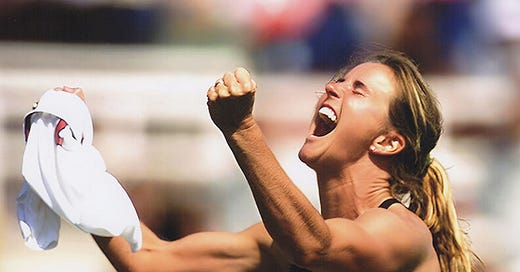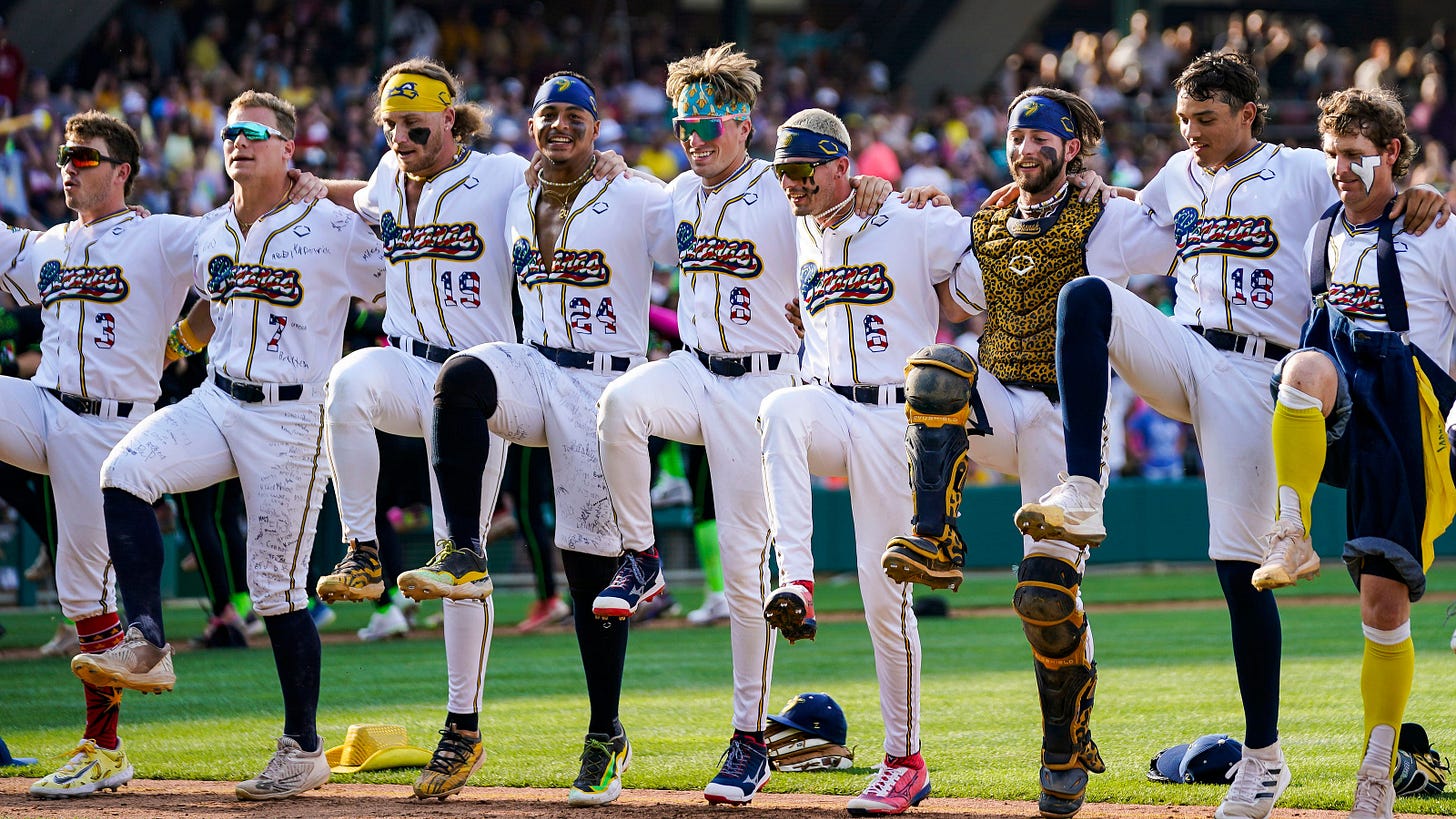What women's sports can learn from Cricket and Caitlin Clark
A masterclass in building an audience fast.
The other day I went with my friend Eva to a Gotham FC soccer game, New York's pro women’s soccer team. Eva is the perfect example of the solution to women’s sports everywhere. She holds season tickets for both the women’s pro soccer and basketball teams and follows women’s sports closer than anyone else I know. If we were all a little bit more like her, women’s sports would be solved.
I was telling my colleague Jamie about my frustration with the in-equality of women's sports and he pointed me to an episode of the Acquired podcast on the Indian Premier League. The IPL is the 4th largest sports franchise in the world by revenue behind the NFL, MBA, and MLB, which is 17 years old in contrast to the NFL’s 105.
It turns out there’s a lot women’s sports can learn from cricket, starting with how to build an audience fast.
Major shoutout to Eva for the notes and stats.
One of my personal philosophies has always been gender equality in a very specific way. I never allow myself to consider gender as a factor in anything I do. That generally works, in work, in skill acquisition, in learning, in communication, gender just doesn’t matter.
But there are some arenas where gender based separation is necessary (aka sports), and in those cases you have to think about equality differently. As I sat in the stands of the Gotham FC game talking to my friend about the NWSL (National women's soccer league), I looked up the average salaries across the league and it pissed me off.
In part, I'm disappointed in myself because I’ve never been much of a supporter of sports. Even as an athlete and former collegiate tennis player, I never watch sports.
Most people are familiar with the decades old plight - female athletes struggle to get paid due to low viewership and engagement with sports for which the male equivalent franchises are billion dollar empires.
And every time this topic comes up, I hear the same excuses: women’s sports aren’t as exciting, not as athletic, not as interesting, and will never be equivalent.
We’re thinking about this wrong. Women’s sports do have athletic excellence, even if it’s proportionally less than the man equivalent, it’s still impressive and worth our attention. Feats of athletic excellence are only one of many reasons people watch mens sports.
Women's sports have an entertainment problem and reputation problem. There are lots of tools to fix that.
Cross-Sport Benchmark
So how are we doing on sport gender equality?
1. Tennis - Hell yeah
Equal prize money for men and women at major events. Tennis Grand Slams pay $3 million to both men's and women's singles champions.
Tennis equality stems from advocacy (e.g., Billie Jean King), broad sponsorship appeal, and close parity in audience numbers at key tournaments.
2. Gymnastics - Unequal in the other direction
In terms of competition prize money, male and female gymnasts earn the same.
Women's gymnastics has significantly higher viewership than men's gymnastics.
Simone Biles’ fame has led her to be the top-earning gymnast in history.
3. Golf - Eh
PGA Revenue: $1.8 billion
PGA Tour prize pool: ~$560 million
LPGA Revenue: $209 million
LPGA Tour prize pool: ~$105 million (⅕ the viewership as well)
Fun fact: Even though the LPGA makes less money and distributes less money, they have a higher proportion of their revenues returning to players. The LPGA distributes 64% of revenue, while PGA distributes 20%.
4. Basketball - Horrific
NBA Revenue: $13 billion
Average NBA salary: ~$9.7 million, 10–15 million viewers per game
WNBA Revenue: $200 million
Average WNBA salary: ~$120,600 (~1.2% of NBA), ~600,000 viewers
5. Soccer - Bad
MLS Revenue: $2 billion
MLS Average salary $594,000. (468,000 viewers for MLS championship game)
NWSL Revenue: $215 million
NWSL Average salary $65,000. (967,900 for NWSL championship game)
Women's soccer got more viewers in their championship and made less money because the women's league overall makes less money.
6. NFL - Not applicable but I was curious
League revenue: $23 billion
Average NFL salary: ~$2.8 million
Viewership of ~17 million; the Super Bowl exceeds 100 million viewers.
What matters the most?
Revenue generation (ticket sales, TV rights, sponsorships)
League/player revenue split agreements
Learning from the IPL
The Indian Premier League, the global organization for cricket was started in 2013 by Lalit Modi, Cricket had always been a major part of the culture for the Indian upper class but was largely inaccessible to the broader population. In the early 2000s with the invention of a new form of cricket that was accessible to the masses, and the rapid modernization of the country as a whole the IPL was established and the commercialization of cricket began.
The first Cricket media rights contract sold for 1 million dollars, 17 years later the most recent media rights contract for cricket sold for $2.4 billion. The reason for that unbelievable growth is that the IPL captured the attention of 98% of India.
There were a few factors that contributed to the IPLs success, one of which was the mind boggling population of India. India's population is 4x the population of the US. Unlike the US which has a multitude of sports to pay attention to, India is a one sport country. Outside of those factors, which we cannot replicate, there were many tactics employed by the IPL to make sure that everyone watched cricket.
1. Maximum entertainment value
Cricket had long existed as an upper class pastime, the standard form of the game could take 5 days to play. Lalit knew that a sport like this could never capture the attention of the masses, he needed a form of cricket that could run from 8-10 every weeknight and thus he invented T20 cricket in which a team gets 120 ‘pitches’, shrinking the games from 5 days to 3 hours.
The other reason that T20 was so successful is because it took cricket from a slow golf-like game of patience and strategy, into a fast paced high scoring game like basketball.
Sports are an entertainment product, and maximization of the entertainment value is critical. Things like dunks, home runs, and snapshots of epic moments are critical to the popularity of a sport.
There are many tools to increase entertainment value that don't require changing the game itself, just watch any NFL game. They inject music, halftime shows, VIP experiences, celebrity sightings, high-quality announcers and mini-games. For streamed games there's sports betting and fantasy, and countless other ways men's leagues build momentum and community.
The Gotham FC soccer game had no music, no exciting announcers, I asked my friend why and she said that's not really the culture of soccer games. I suggest we question that. I suggest we rethink everything in the spirit of building viewership and engagement.
For example the Minnesota United (Men’s MLS team) plays “Wonderwall” in the stadium every time MNUFC wins, driving fans to stay after the game to sing the chorus together.
The Savannah Bananas
Like the IPL the Savannah Bananas embraced the idea of maximum entertainment value.
The Savannah Bananas were a minor league baseball team that opted to change the game in order to maximize the entertainment value. In 2018 they created the game of ‘banana ball’ a modified version of baseball. Some of the rule changes they made included — No bunts, no walks, foul balls caught by fans counted as outs, music played at all times, dancing while playing was encouraged, among others.
The Bananas also built out a huge media presence, their TikTok account has more followers than all of the MLB teams accounts combined.
Seven years in, their four-team league the BBCL (Banana Ball Collegiate League), is estimated to do $51 million in revenue per year with extremely rapid growth adding new teams and more games every year.
With the trajectory it's on, pretty soon this goofy banana ball league will do more revenue than any of the women's major sports leagues.
I bring this up to highlight that leaning in to entertainment value turned a non-sport into a money making machine, so imagine what it can do for actual sports.
A controversial option for increasing entertainment value is the idea that women's sports should be modified.
The first time I heard it, I had a visceral negative reaction. But when I reorient myself towards the goal of wanting equal viewership and pay in women's sports, I can consider the possibility.
There is a white paper in PubMed that explores the impact of physiological measurements on style of play. In conclusion— yeah its different but if men were to play a sport designed for a 30% larger ‘superman’ their play would look similar to the way women play today.
People have posed the idea of lower hoops in women's basketball to increase dunking or shrinking field size in soccer to increase goals/action.
I don't play either of these sports so I don't have a dog in this fight but I can highlight the pros and cons.
The primary risk is that people lose respect for the women's version of the sport. The secondary risk is that making the sports different removes the ability for co-ed play which is one of the factors that drives love for the sport through adulthood.
There are examples in which this has been done well:
Tennis: In majors, women play two out of three sets while men play three out of five. All other rules remain the same. While deep down this irks me a little bit, it has probably made women's tennis more watchable and interesting, and so I wouldn't push back against it. I’m certain women could play just as long as men could. But I'd choose more viewers and more support for the athletes over proving that point.
Cross country: Women’s races are sometime’s shorter than men’s but men and women’s run clubs / teams always train together
Volleyball: Net heights are 7'11" for men, 7' 8" for co-ed, and 7' 4" for women.
In these cases, the changes haven’t fundamentally changed any aspect of the game, they don’t limit co-ed play, most people probably don’t even realize they’re different.
In other cases changes have made the women’s sport more conservative and less interesting.
For example, women's lacrosse and hockey restrict nearly all contact, in a contact sport. WTF. In both of these cases, these rule changes removed a critical physical element of the game, which I would never advocate for. It’s key that if changes are applied to a sport it undeniably makes the game more exciting and respected.
More dunk highlights might increase WNBA viewership, but I think it’s a minor tool in our toolkit of solutions. Minor changes in play dynamics are far less important than building a high quality entertainment product overall.
2. Know your competition.
The IPL knew their goal was to be on every TV in the country from 8 to 11. But they ran into a new issue. Men watched cricket, but women controlled the tv remote. That's when the IPL realized that their competition wasn’t other sports, it was the soap-operas and reality TV shows that women might want to watch instead.
And that's when Modi made his next genius move. Modi decided to merge Bollywood pop culture with cricket.
Modi arranged for the biggest Bollywood stars, TV personalities, and beloved characters to buy and own each of the major cricket teams. It would be as if Kylie Jenner owned one women's soccer team, Obama owned one and Taylor Swift owned another.
Patrick & Brittany Mahomes’ ownership of the KC Current (women’s soccer team) has driven incredible popularity for the women’s soccer team. Kansas City people LOVE the chiefs, when the Chiefs’ star quarterback shows love for women’s soccer, Kansas City people decide to love women’s soccer too.
There is a massive investment opportunity that only a few PE firms are taking advantage of, the San Diego Wave (NWSL team) investor made 50x in 2 years $2m expansion fee —> $113m valuation.
In the U.S. we've been seeing this integration of sports with pop culture in a different direction.
Now that fame has been democratized through social media platforms and podcasts, we're seeing many more athletes becoming media personalities. Caitlin Clark alone has driven so much appreciation and acknowledgement for the WNBA. She's clearly an extremely dominant player, but in large part it’s her media fame that has driven recognition for the WNBA.
Men’s sports teams often have a ‘face of the franchise’. For individual sports like tennis and Gymnastics, star athletes Coco Gauff, Serena Williams, and Simone Biles have played that role. Caitlin Clark is the most recent example women’s team sport ‘face of the franchise’ and we need more.
Every game where Caitlin (Indiana Fever) played had extremely high viewership / sold out crowds, but overall viewership in the WNBA was up regardless of which team was playing. The media had tons of headlines last year that “Caitlin Clark’s games are watched [10x] more than every other WNBA game”. Voices in women’s sports were SO pissed off by these headlines. Viewership is up across the league, stop telling people that “the only reason people care about women’s basketball is Caitlin Clark.”
Fair, it’s irritating, but doesn’t mean we shouldn’t lean in.
This a phenomenon that crosses genders. More people watch basketball when Lebron or Steph Curry play. More people watched golf because Tiger Woods was on the course. More people watch the Chiefs when Taylor Swift is dating Travis Kelce.
Stars drive views. So lets make more female athlete stars.
Social media creates an enormous opportunity for women to market themselves and finally compete with men on an even playing field. 4/5 of the most followed athletes from 2025 March Madness were women.
Another reason for the WNBA and other women’s sport’s recent success has been the fashion X sports crossover. Paige Bueckers modeling major fashion houses, Coco Gauff sponsored by Miu Miu.
Who owns your team matters.
Knowing the players matters.
Appealing to pop culture matters.
Women's sports need to give people more reasons to watch. I wish as much as the next person that the sport itself was enough of a reason. But the data is showing us that's not the case.
3. Change the behavior of future generations
The biggest problem of them all for women's sports is that women don't watch sports. And that is a really hard problem to solve.
It's going to be much easier to get an 8 year old girl watching sports than a 25 year old girl.
Why is it that every 8 year old boy grows up watching sports, talking about them, playing them? Because that’s what their friends do.
These changes happen generation by generation. So every woman and man who says they want equality should be telling their little boys and little girls to watch and talk about women's sports too.
So what now?
I think we all want to see equality, and we all have a role to play in getting there. While I deeply hope the league owners are studying the IPL & The Bananas, so women’s sports can get on that trajectory, what we can do is pay attention. Watch & follow female athletes. Make talking about it cool.
We should all remove the idea from our discourse that women's sports are boring, and make sure all the little girls think that female pro athletes are the coolest people in the world.
I am trying to change my own habits and become a 26-year-old newfound women’s sports fan.
To do that I've asked Eva to tell me who to follow and what to watch to get engaged. Here’s what I’m starting with in case you’d like to come on this journey with me.
Accounts to follow:
Just women’s sports newsletter & X
Drop a comment with more recs if you have them!








